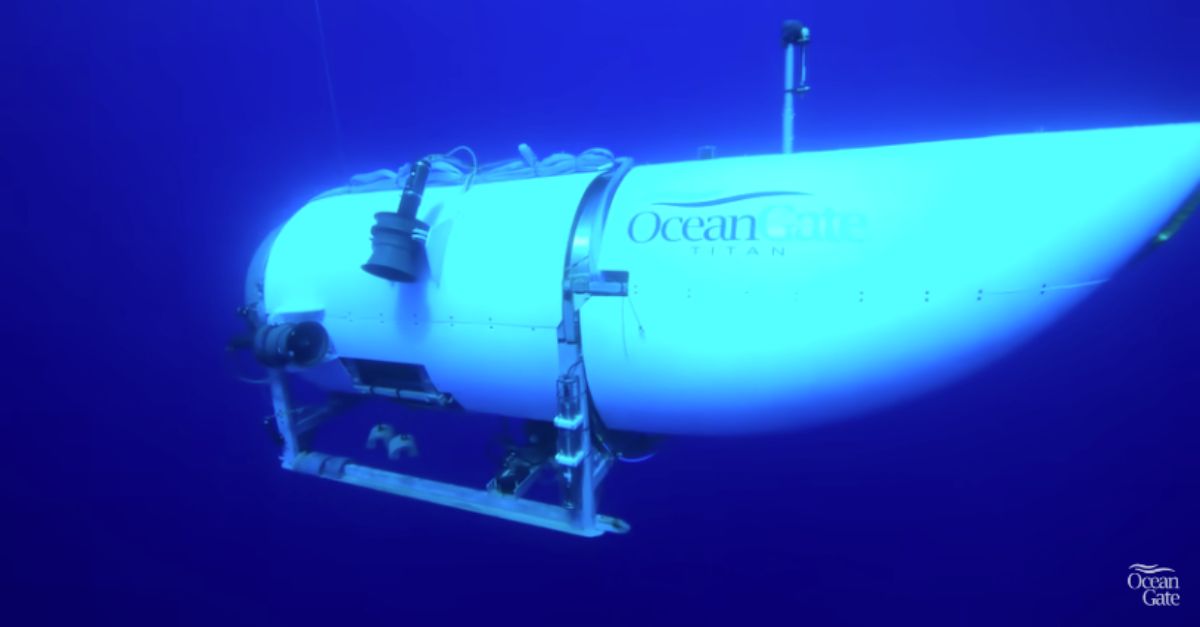
Image of OceanGate Titan submersible via OceanGate.
The company behind an underwater Titanic exploration vessel that has been missing for three days was previously accused of ignoring safety concerns and risking “potential extreme danger,” according to a years-old whistleblower lawsuit.
David Lochridge, the former Director of Marine Operations at OceanGate, had sued the company in 2018 over his firing earlier that year. Lochridge alleged that he was kicked out of the company for repeatedly raising safety concerns over its Titan vessel — the same one that lost contact with its support ship on Sunday some one hour and 45 minutes after launching an expedition to view the remains of the R.M.S. Titanic. Five people, including OceanGate CEO Stockton Rush, were on board when the submersible began its mission Sunday to see the ill-fated ocean liner.
In a January 2018 quality inspection report, Lochridge flagged concerns over the Titan’s ability to stand up to the pressure of diving to 4,000 meters, or around 13,000 feet — the depth of where the Titanic lay on the ocean floor.
“Lochridge first expressed verbal concerns over the safety and quality control issues regarding the Titan to OceanGate executive management,” the complaint says. “These verbal communications were ignored.”
Lochridge addressed these unheeded concerns in his written report, which warned against handing the Titan over from the company’s engineering department to operations.
“[N]ow is the time to properly address items that may pose a safety risk to personnel,” the report said, according to the lawsuit. “Verbal communication of the key items I have addressed in my attached document have been dismissed on several occasions, so I feel now I must make this report so there is an official record in place.”
Specifically, Lochridge wanted OceanGate to conduct “non-destructive testing,” which he described as “critical to detect such potentially existing flaws in order to ensure a solid and safe product for the safety of the passengers and crew,” according to the lawsuit.
He was told that such tests weren’t in the cards.
Per the lawsuit:
Lochridge was told that no form of equipment existed to perform such a test, and OceanGate instead would rely solely on their acoustic monitoring system that they were going to install in the submersible to detect the start of hull break down when the submersible was about to fail.
Lochridge again expressed concern that this was problematic because this type of acoustic analysis would only show when a component is about to fail — often milliseconds before an implosion — and would not detect any existing flaws prior to putting pressure onto the hull.
Lochridge’s report noted the “prevalent flaws” in the testing of a one-third scaled model of the ship, as well as the “visible flaws in the carbon end samples” for the Titan, posing “potential danger to passengers” as the submersible went ever deeper in the ocean.
He also noted that in the course of his report, in requesting information from the Engineering department, he had been “met with hostility and denial of access to the necessary documentation that should have been freely available as a part of his inspection process.”
The day after Lochridge issued his report, he was called to a meeting with Rush, the CEO, and other top officials in the engineering and operations departments, as well as human resources.
“At the meeting, Lochridge discovered why he had been denied access to the viewport information from the Engineering department — the viewport at the forward of the submersible was only built to a certified pressure of 1,300 meters, although OceanGate intended to take passengers down to depths of 4,000 meters,” Lochridge’s lawsuit said.
The manufacturer of the viewport, which functions essentially as a submersible’s window, refused to certify beyond a depth of 1,300 meters “due to the experimental design of the viewport supplied by OceanGate,” which was outside of the standards for Pressure Vessels for Human Occupancy (“PVHO”) standards, the lawsuit said.
Read Related Also: Toddler Finds Loaded Hangun, Fatally Shoots Pregnant Mom
“OceanGate refused to pay for the manufacturer to build a viewport that would meet the required depth of 4,000 meters,” the complaint added.
This left OceanGate customers — who were expected to pay an average of $250,000 per person to take what the company has advertised as “once-in-a-lifetime missions” — in the dark, according to Lochridge.
“The paying passengers would not be aware, and would not be informed, of this experimental design, the lack of non-destructive testing of the hull, or that hazardous flammable materials were being used within the submersible,” the complaint says.
More from Law&Crime: Real estate heir accused of murdering his mother for inheritance money during a fishing trip dies in pretrial detention
When Lochridge “again expressed concerns regarding the quality control and safety issues relating to the Titan” and “insisted that OceanGate perform non-destructive testing on the experimental hull” — in addition to urging OceanGate to use an agency to certify the submersible — he was “immediately fired.”
“OceanGate gave Lochridge approximately 10 minutes to immediately clear out his desk and exit the premises,” the lawsuit notes.
OceanGate accused Lochridge of filing a false claim with the Occupational Health and Safety Administration (OSHA), which Lochridge denies.
In his lawsuit, Lochridge noted that he was told by Rush that he had been hired to do the inspection because he was the “best man for the job” and had significant experience working with submersibles. Lochridge acknowledges in the complaint that he wasn’t an engineer, but says that his job duties included ensuring “the safety of all crew and clients during submersible and surface operations.”
In a 2022 interview with CBS News, Rush told reporter David Pogue that there is a “limit” to safety precautions.
“You know, at some point, safety just is pure waste,” Rush said. “I mean, if you just want to be safe, don’t get out of bed. Don’t get in your car. Don’t do anything. At some point, you’re going to take some risk, and it really is a risk/reward question. I think I can do this just as safely by breaking the rules.”
Pogue had been invited to join an expedition to the Titanic, and in his piece, he had expressed concerns over the fact that the Titan used construction pipes for ballast and was steered using a video game controller.
OceanGate had sued Lochridge in June 2018 for breach of contract, fraud, and stealing trade secrets. In August of that year, Lochridge countersued for wrongful termination, alleging that the company fired him instead of taking his concerns seriously.
The lawsuit case was dismissed in November 2018 pursuant to a settlement agreement, according to court filings.
“Mr. Lochridge has no comment,” a lawyer for Lochridge told Law&Crime in response to a request for comment. “We pray for everyone’s safe return.”
Read Lochridge’s lawsuit, below.
Have a tip we should know? [email protected]








